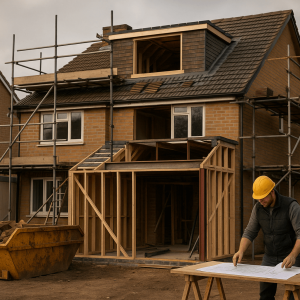An estimator measures your drawings, prices labour, materials and prelims, then builds a clear breakdown so quotes are comparable and risks are explicit (UK).
Planning an extension, loft conversion or new build and wondering who turns drawings into a reliable number? This guide explains what an estimator does, what you should receive, typical pricing models, and how to brief an estimator so you get accurate, like-for-like quotes. For deeper dives, see Construction Cost Estimating – A Comprehensive Guide, RICS New Rules of Measurement – Complete Guide, and UK Builder Day Rates and Labour Costs.
Table of Contents
- Introduction
- 1. What Estimators Do
- 2. What You Should Receive
- 3. Typical Pricing Models (and Benchmarks)
- 4. How to Brief Your Estimator
- 5. How to Compare Quotes
- 6. Usual Timelines
- 7. UK Standards: RICS, RIBA, CDM, VAT
- Conclusion & Next Steps
- Frequently Asked Questions
Introduction
An estimator turns design intent into a structured cost. They measure quantities from drawings, test market rates, and build a breakdown that lets you compare builder quotes fairly. On smaller projects, the same person may also advise on procurement and value-engineering options.
1. What Estimators Do
In plain English, an estimator:
- Measures quantities from drawings and specifications.
- Prices labour, materials and plant using current market information.
- Includes preliminaries (site setup, supervision, welfare) and realistic methods.
- States risks, assumptions, exclusions and any provisional sums.
- Structures the cost so different quotes can be compared like-for-like.
If information is incomplete, they will use sensible allowances and clearly flag what needs confirming before a fixed price is issued.
2. What You Should Receive
Ask for deliverables that make decisions easy:
- Order-of-cost estimate (early design): high-level allowances by element when drawings are still developing.
- Elemental cost plan: breakdown by building elements (for example substructure, superstructure, services) with assumptions and exclusions.
- Trade breakdown or Bill of Quantities (BOQ): quantified items with units, rates and totals for like-for-like tendering.
- Assumptions & exclusions log: what’s included, price validity, and risks/contingency.
For context on BOQs and structure, read Mastering Bills of Quantities – Tips and Tricks.
3. Typical Pricing Models (and Benchmarks)
Estimating work is usually priced in one of three ways:
- Day rate: common for open-ended or complex scopes. Experienced estimators often sit in the mid-hundreds per day (ex VAT), varying by region and sector.
- Fixed fee: used for a defined deliverable (for example measured take-off and summary for a small residential project). Small-project fees typically start in the low hundreds (ex VAT) and scale with size, complexity and turnaround.
- Hybrid: a capped day-rate for core tasks plus pre-agreed extras for changes.
Base date: Q4 2025. Region: Great Britain. VAT stance: figures discussed here exclude VAT unless stated.
If you want ballpark build costs per m² for context, see Building Cost Estimator – UK.
4. How to Brief Your Estimator
- Latest drawings (plans, sections, elevations) and any structural/MEP information.
- Specification/schedules (windows, finishes, sanitaryware, heating, electrics).
- Site details (photos, access, parking, working hours, constraints, known surveys).
- Programme (target start/finish, phasing) and procurement route (single-stage tender, negotiated, etc.).
- Client-supplied items or PC sums to include; any sustainability targets or alternates.
Tip: freeze drawings before pricing to minimise rework and reduce variation risk. For accuracy tips, see 5 Tips for Accurately Estimating Building Costs.
5. How to Compare Quotes
- Scope match: make sure all bidders priced the same drawings/spec.
- Prelims/OHP/risk visible: avoid vague “TBC” allowances.
- Basis of rates: ask for supplier quote validity dates and labour assumptions.
- VAT confirmed: standard rate is 20% unless a qualifying relief applies; get this stated on the quote.
Need a primer on the difference between a headline quote and a professional estimate? Read Estimating vs Quoting – What’s the Difference?.
6. Usual Timelines
- Small domestic estimate: typically 3–7 working days from complete information.
- Elemental cost plan: around 1–2 weeks depending on design maturity.
- BOQ (single house-type): around 1–3 weeks; longer for multi-plot or complex MEP packages.
Lead times move with seasonality, market activity and how quickly suppliers return prices.
7. UK Standards: RICS, RIBA, CDM, VAT
RICS NRM: the UK standard for structuring estimates and measurement. NRM1 covers order-of-cost and cost planning; NRM2 covers detailed measurement; NRM3 covers maintenance planning.
RIBA Plan of Work: use stages 0–7 to time outputs—early budgets at 1–2, BOQs at 4, reporting during construction at 5.
CDM 2015: estimators should include realistic preliminaries for welfare, supervision, access and logistics in line with health & safety duties.
VAT: most construction services are standard-rated at 20%. Some residential works can qualify for reliefs (for example certain energy-saving measures). Always confirm the correct rate and keep evidence.
For plain-English background, see Decoding the Maze of Estimating Building Costs in the UK and our Estimating Building Materials guide.
Conclusion & Next Steps
Estimators turn drawings into dependable numbers so you can make confident decisions and avoid budget shocks. Ask for clear deliverables, confirm assumptions and VAT, and compare quotes line-by-line. If you’re ready for a tailored estimate, request a quick quote now.
Frequently Asked Questions
What’s the difference between an estimator and a quantity surveyor?
Estimators focus on pre-contract pricing and tender submissions. Quantity surveyors typically manage costs during construction, valuations and final accounts. On smaller jobs one person may do both.
Is an estimate legally binding?
No. An estimate is a professional calculation that can change if scope, design or site conditions change. A quote is a fixed price offer once accepted.
How are preliminaries and profit handled?
Preliminaries cover site setup, supervision, welfare, access and logistics. Overheads & Profit reflect business overheads and a margin appropriate to risk and market conditions.
Do estimators follow a standard format?
Yes. RICS NRM is widely used in the UK for structuring estimates and detailed measurement, which helps make quotes comparable.
How do I speed up the process?
Issue complete, current drawings and specifications, agree assumptions up-front, and provide clear programme dates and any client-supplied items.











